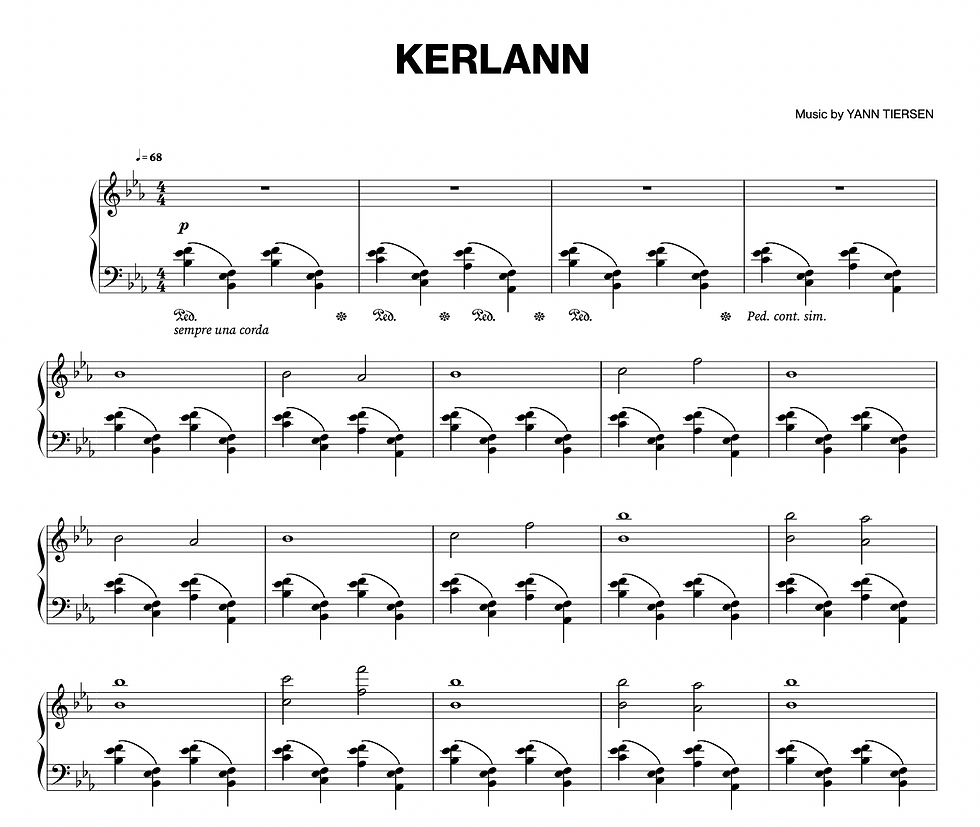The Harmony of Yann Tiersen
- Almudena Longares

- Nov 14, 2023
- 3 min read

Did you notice how the music of Yann Tiersen evokes calmness in his
harmonic chord progressions, but it doesn't follow any clear ¨harmonic functional¨ rule?
If we focus exclusively on the harmony, there is something that really might catch your attention.
All the arrangements have in the start, a repetitive "vamp of chords" , which sounds smooth and stable - but at the same time has something special on it, doesn't seem to follow the usual harmonic functions. There are steady, colourful and vivid, but they have certain magic and unexpectation on them.
In the very beginning, my first guess was the most logical one: He is creating this colours with Modes. Pretty easdy! He might be creating the chords using modal scales,a dn that´s why they always sound colorful but special.
It took me very less time to release that this theory is not working for this musician.
Major part of his compositions can´t be analysed with a mode.
I continued analysing his compositions (as you will find in the examples bellow) and that´s when things started to make sense.
(clap, clap, clap)
I feel the most accurate way to define his composition technique is ¨Common tone Harmony¨ I got you!
This is a really simple technique used by big composers such as Danny Elfman, Philip Glass, or Howard Shore.
As you can see between all the chords there is one or two notes in common. This was used in previous periods of time as as way of modulation (common chord modulation - common tone modulation) but in this case he is using it as a whole composition tool itself.
Ok, but let's go to the point, how does this work?
You try to use chords which has certain notes in common, maintaining like this smoothness and stability between chords, but you are not giving a clear direction to the chords, which transmits - psycologically - a lot of calmeness.
When you want to provide a bit of "magic" or to move to a second idea or vamp, you switch to a new structure without notes in common with the previous one.
This allow you to move between different quality of chords and functions with great stability between them, but at the same time to experiment freely with colours and textures.
It reminds me to a game I used to play with my family called "Chained words" where you needed to create a new word with the ending of the one provided previously.
Please, note that even if that's the basic analysis of the situation, in some of his compositions he mixes classical harmonic functions (for instance in his songs " La Dispute" o " La Noyée" which are minor songs he converts the last chord in a Dominant to end the circle in a perfect cadence V-I, or in songs as " The Val's to Amelie" seems to me a modal harmony constructions, in this case dorian") In my opinion major part of contemporary composers use mixed techniques, since now there is not an "academia".
Let's transcribe and reduce some of his harmonic progressions to understand a bit better how does it work. Do not hesitate in use this tehcnique for your own compositions!
You will see what wonderful results you will get, just with a bit of imagination.
N.I.C refers to"notes in common"
1) La dispute:
(reduction of the music score)

Original music score:
2) Comptine d'un autre:

(reduction of the music score)

3) La matin:
(reduction of the music score)

4) Vals D'Amelie:


5) La Noyée:
(Reduction of the music score)

6) Jours Triste:

7) In Atlantique Nord

******Please do find more examples at the end of this article.
You can find the link to all the music scores I have named, and more here:
8) Summer 78
Note in common between chords: 2.

9) November
Notes in common between chords: 3

10) Ar Maner Kozh: min. 1 usual 2.

11) La plage: Notes in common between chords: 1

12) Ker Yegu: Notes in common between chords: 2

13) Poull Bojer: Notes in common between chords: 1

14) Notes in common between chords:

15) Kerdrall
Notes in common between chords: 2

16) Kerlann
Notes in common between chords: 2

17) Yuzin
Notes in common between chords: 1

18) Pern
Notes in common between chords: 2

19) First Rendez - Vous
Notes in common between chords: 2

20) Le Banquet
Notes in common between chords: 1

21) Le Moulin
Notes in common between chords: 2

22) Mother's Journey
Notes in common between chords: 2

23) Kadoran
Notes in common between chords: 1 or 2

24) September
Notes in common: Usual 2, sometimes 1.

25) Ker Al Loch
Notes in common between chords: 2 or 3.

That´s it for my small thoughts of today! see you all in the next small blog!
.png)
.png)
.png)
.png)





Comments